.

How To Protect Your Cannabis Plants From Cochineal Invasions
One of the last things you want to see living on the surface of your weed plants is the cochineal. These little beasts can reproduce rapidly and amass huge numbers. They have a fond taste for the sap of your plants, and can spread throughout your crop, sucking their life force away. Here's how to recognise, prevent, and fight a cochineal invasion.
Contents:
- What is the cochineal?
- How are cochineals harmful to cannabis?
- How do cochineals spread?
- How to prevent cochineals
- How to fight an invasion of cochineals
- Prevention is the best cure in fighting the cochineal
- How to deter large insects
- Shield your weed from small insects
- Keep your crop safe from hungry animals
Whether you choose to cultivate your beloved cannabis crop indoors or outdoors, it is a possibility that you will at some point be subject to a pest invasion.
One such pest is known as the cochineal. With its strong appetite for the sap within cannabis plant matter—a substance your plants need to survive, thrive, and pump out healthy and large yields—the cochineal is particularly destructive.
What Is the Cochineal?
There are around 8,000 types of cochineal, but when it comes to cannabis cultivation, two are particularly problematic: the cottony cochineal, aka the mealybug, a white, fluffy bug known to many growers, and the brown soft scale cochineal. Both prefer hot, dry environments, and they survive by sucking the critical life force (sap) from your precious specimens.
-
Cottony Cochineal
More commonly known as the mealybug, this species of cochineal originates in the tropics, and is mobile. Once a female latches onto a plant, her legs are shed, preventing her from leaving the plant. The males, however, are equipped with wings, and thus are more mobile.
Cochineals can reproduce extremely fast, which is not great news for those who come across an infestation. Females can give birth to as many as 2,000 offspring in optimal conditions. These creatures thrive in dry and warm conditions, with populations able to double every five days. They are known as “cottony” because they produce a cotton-like substance on themselves that helps to protect their eggs.
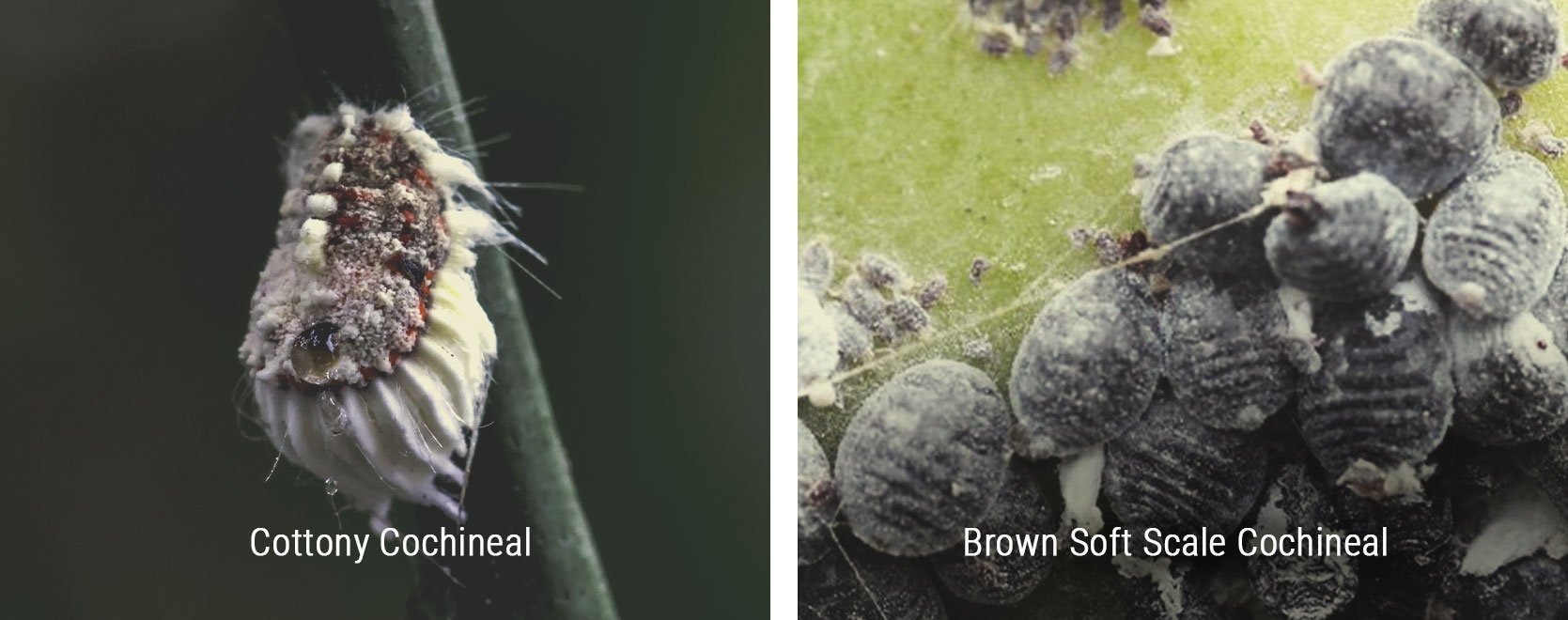
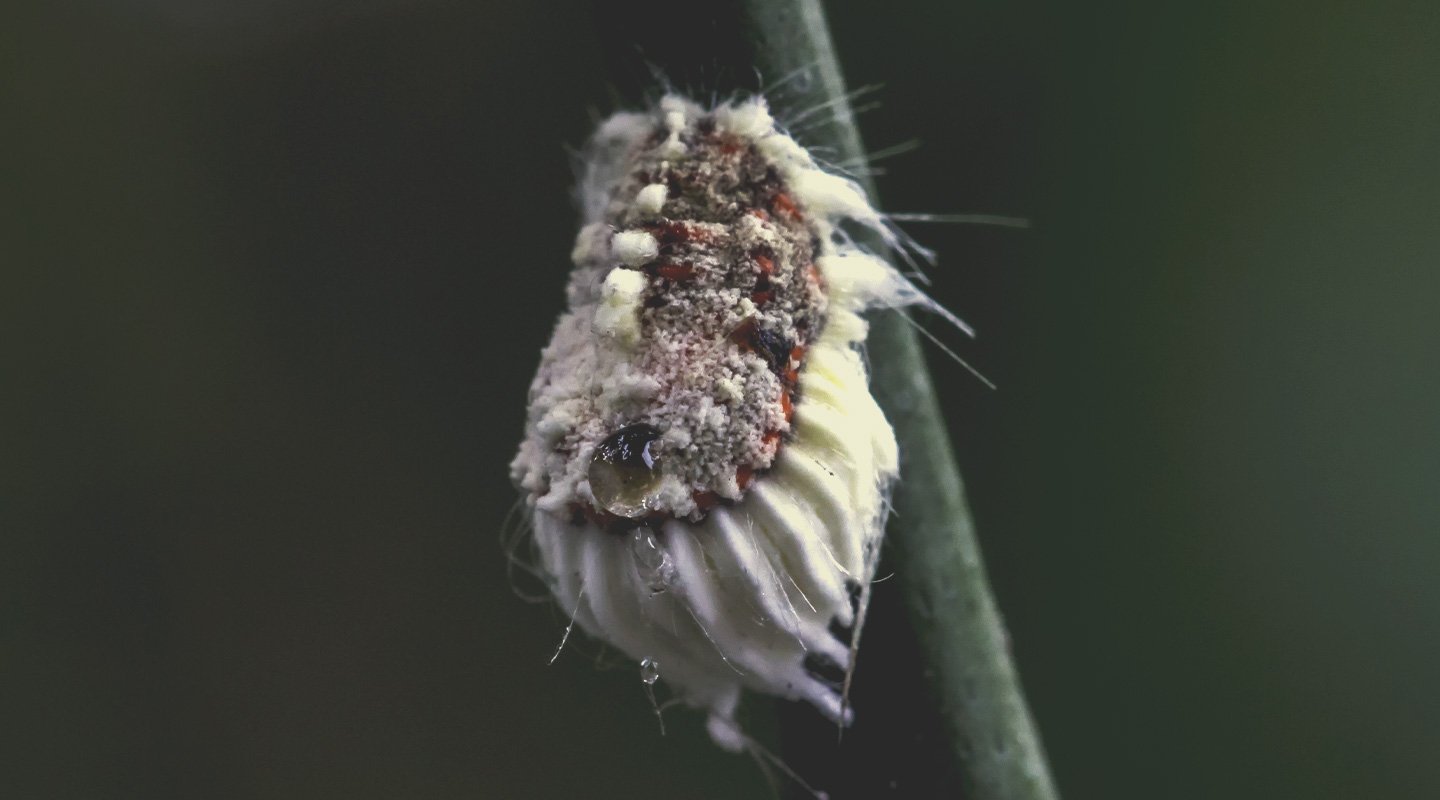
-
Brown Soft Scale Cochineal
The brown soft scale cochineal originates from Central America, and is a parasitic species that naturally survives on cacti. Like the cottony cochineal, the males are highly mobile and fly around looking for females to mate with. The females have small legs that they use to crawl to a host space, usually the internodes, where they latch on and their legs drop off.
The Aztecs used to harvest this species from the underside of cacti, using deer’s tails as brushes. They would then use the carminic acid within to create carmine, a red dye. The Spaniards then exported this back to Europe, where it became a favourite for dying clothes. Today, it is used as a natural food and cosmetics colouring.
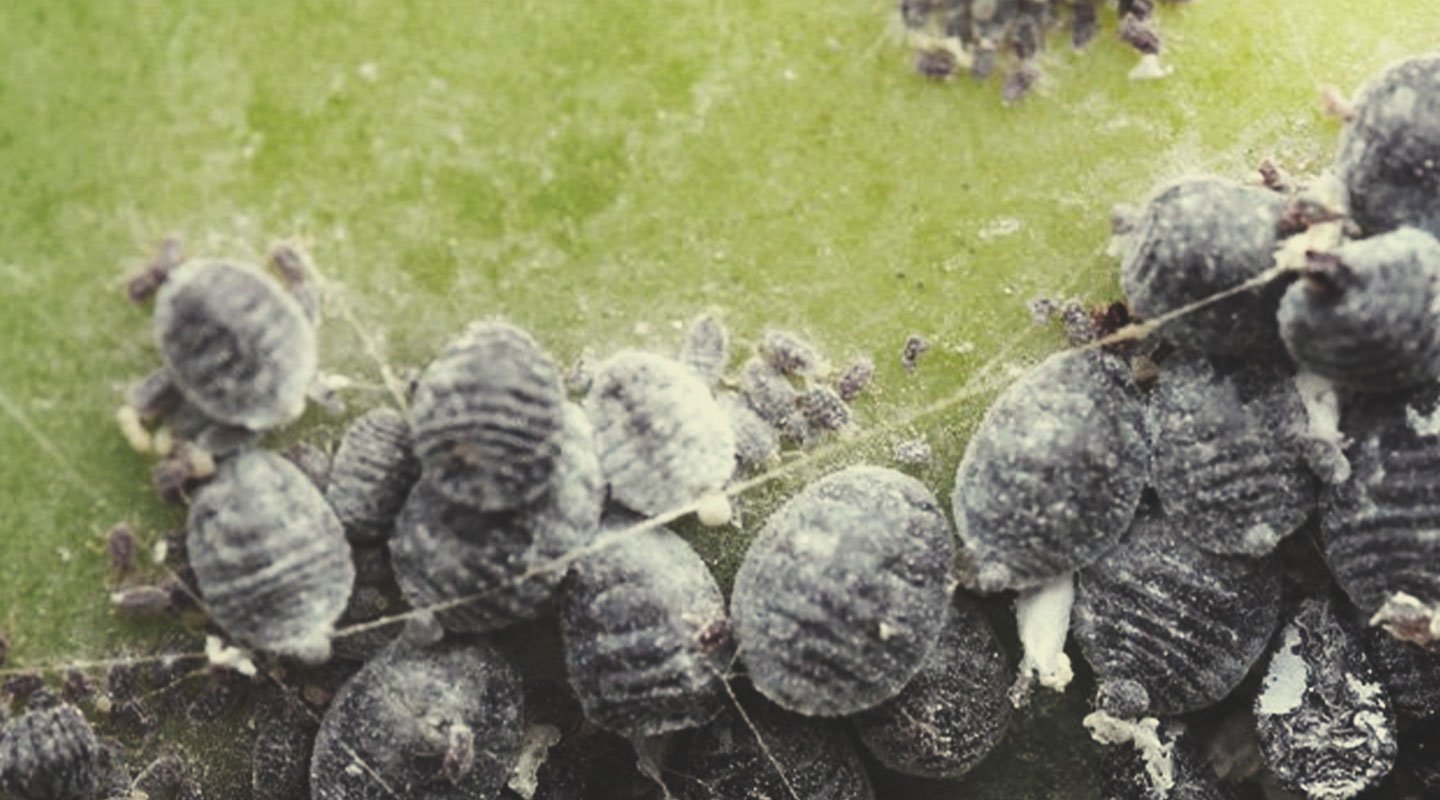
How Are Cochineals Harmful To Cannabis?
Cochineals are harmful to cannabis in a number of ways.
First, they suck the sap out of the plant, stealing its nutrients. As they breed in such high numbers, this can significantly weaken a host plant. Though the infestation itself may not be fatal, it is likely to negatively affect growth, yield, and final quality. However, it is not just their feeding that is bad for the plants.
In order to access the xylem of the plant, they must penetrate it with their sucking mouthpart. Much like a cut to the skin, damage to the outside of a plant opens the door for bacterial and viral infection. So your plant may have much of its nutrients taken, only to find itself infected and with a reduced capacity to fight off said infection.
Finally, cochineals secrete what is known as honeydew, as do aphids and other pests. This sugary substance attracts ants, fungus, and bacteria.
Given all this, it’s important to identify and deal with a cochineal infestation as soon as possible. Not only do they present a problem in themselves, but they can invite other, even more problematic infestations to the party if left to their own devices.
How Do Cochineals Spread?
Cochineals are able to crawl over relatively easy terrain and can relocate to plants that are within 10 metres from their original location. They are not great at dealing with rough ground, though, and for that reason, gravel and uneven soil can be a challenge for them.
Wind also plays a role in how cochineals move from plant to plant. They can be swept away for long distances. Their hairs actually catch and ride the wind like the sails of a sailboat.
How To Prevent Cochineals
One method of protecting your flourishing weed plants from a potential cochineal invasion is to create a buffer zone. This option is much more practical in an outdoor setting. Using plants such as rose bushes, growers can create a vegetative barrier around their weed that can take the invasion in their stead.
As well as serving an ornamental function in the garden, growers can check these defensive companion plants regularly to see if cochineals are present, before the pests have the opportunity to reach your cannabis plants.
As mentioned, the cochineal loves dry and warm climates. Therefore, if you act to prevent these conditions, you can create a strategy to prevent their invasion. Obviously, too wet and humid of a climate can create hospitable conditions for other threats, such as mould. With that in mind, a solution could be to uphold conditions wherein the moisture content is just unfavourable enough for mealybugs and brown soft scale cochineal.
Another method of prevention includes introducing the gracious ladybug into your growing environment. These majestic beings will serve as bodyguards for your cannabis plants, as they are natural predators to the cochineal. They will also serve to protect against other pests, such as spider mites.
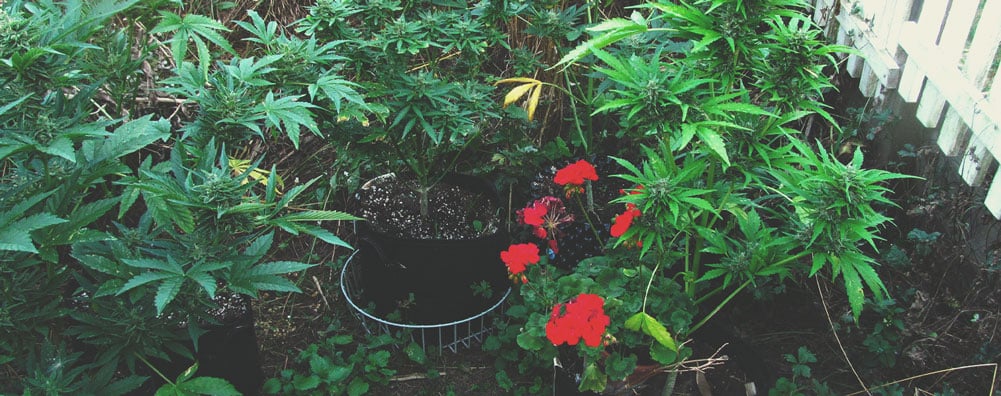
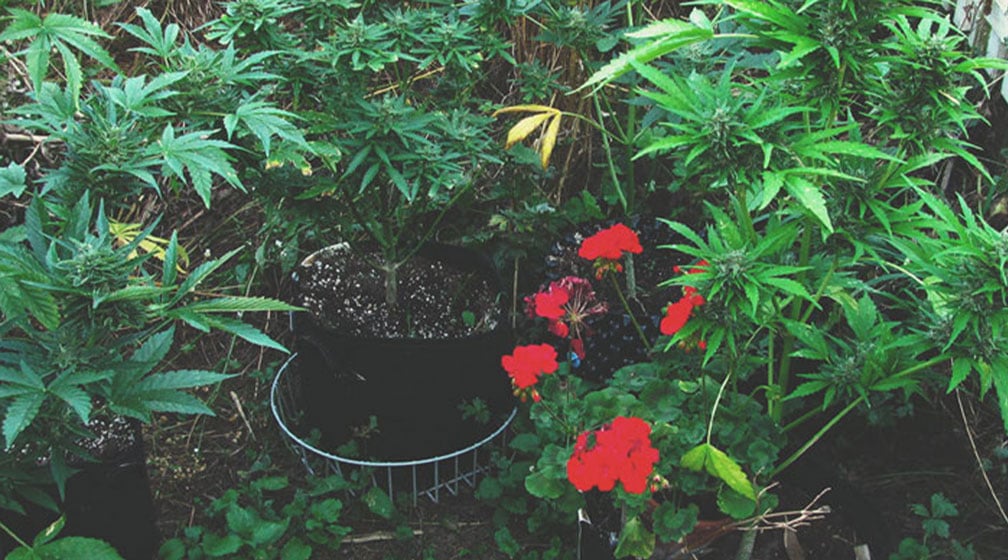
How To Fight an Invasion of Cochineals
So, let's get to the process of how to kill mealybugs and brown soft scale cochineals if you find yourself with an infestation. Once cochineals have begun to settle on your crop, they will get to draining the sap, affecting the overall health and performance of your plants. As soon as you see an invasion taking place, it is important to separate the infected plants from the rest of the crop to prevent any further spread. Once this has been completed, thoroughly check the rest of your plants to be sure that they are safe.
Some growers may choose to use insecticides at this point to eradicate this pest entirely. However, the cochineal has a protective outer shell that may protect them from this. Additionally, some growers prefer not to use pesticides due to their knock-on environmental effect.
If you don’t want to use synthetic pesticides, here are some other options:
| A concoction of alcohol or soap can be used against them. Add a spoonful of soap into a litre of warm water. Adding methanol to this mixture is also an option. Once mixed, apply it onto your affected plants as a foliar spray. |
| Using natural predators is another great option. Again, the ladybug is a great choice for this. Similarly, parasitic wasps can be used, depending on whether or not you want them living in your garden. |
| Another mixture involves dissolving tobacco into soapy water and applying it in the same way as the other mixture. |
| Oregano mixed in water, and fern leaves mixed in water, can also be used to fight off cochineals. |
| Diatomaceous earth is a type of sediment made up mostly of silica. It is a completely organic, siliceous mineral. Being microscopic, it pierces the bodies of pests, causing them to die of dehydration. It therefore works as a non-polluting pesticide in your grow. One thing to be aware of, though, is that it can neutralise acidic soil, which may not be good for your cannabis. |
| A potassium soap and neem oil mixture is another ecologically friendly pesticide. It can both prevent and eradicate infestations, making it useful in multiple situations. Chanceadictin, a compound present in this mixture, stops larvae from entering the adult stage of life, and therefore halts reproduction. Moreover, beneficial garden fauna, such as ladybugs, will not be harmed. And it works as a fungicide too, helping with issues such as powdery mildew. |
Prevention Is the Best Cure in Fighting the Cochineal
Cochineal, both brown soft scale and mealybugs, can be incredibly damaging to your crop. As with all ailments, avoiding them in the first place is the best way to protect your plants. Measures such as buffer plants and neem oil should help to stop a full-scale infestation. Combine this with the introduction of beneficial fauna, and you should hopefully find your grow pest free.
However, there’s always a chance something slips through your defences. This is why regular health check-ups are so helpful—you want to catch things early. If you identify an invasion, act fast and don’t be afraid to use an aggressive method. Removing them as quickly as possible will cause you, and your plants, the least amount of stress possible.
























































